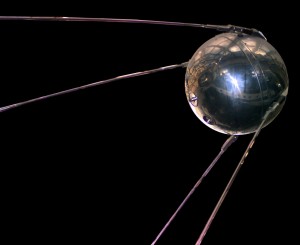Good morning, Whitewater.
We’ll have about a one-third chance of showers, on a Saturday with a high of forty-six.
Saturday Night Live has a suggestion for the NFL on player introductions. One can think of it as a version of truth-in-advertising:
On this day in 1957, the Soviets launch Sputnik 1 into orbit:
The Sputnik rocket was launched on 4 October 1957 at 19:28:34 UTC (5 October at the launch site[1]) from Site No.1 at NIIP-5.[53] Telemetry indicated the side boosters separated 116 seconds into the flight and the core-stage engine shut down 295.4 seconds into the flight.[51] At shut down, the 7.5 tonne core stage with PS-1 attached had attained an altitude of 223 km (139 mi) above sea level, a velocity of 7,780 m/s (25,500 ft/s) and velocity vector inclination to the local horizon of 0 degrees 24 minutes. This resulted in an initial orbit of 223 kilometres (139 mi) by 950 kilometres (590 mi), with an apogee approximately 500 kilometres (310 mi) lower than intended, and an inclination of 65.1 degrees and a period of 96.2 minutes.[51]
19.9 seconds after after engine cut-off, PS-1 separated from the second stage[1] and the satellite’s transmitter was activated. These signals were detected at the IP-1 station by Junior Engineer-Lieutenant V.G. Borisov, where reception of Sputnik’s “beep-beep-beep” tones confirmed the satellite’s successful deployment. Reception lasted for two minutes, until PS-1 fell below the horizon.[28][54] The Tral telemetry system on the R-7 core stage continued to transmit and was detected on its second orbit.[1]
The designers, engineers and technicians who developed the rocket and satellite watched the launch from the range.[55] After the launch they drove to the mobile radio station to listen for signals from the satellite.[55] They waited about 90 minutes to ensure that the satellite had made one orbit and was transmitting, before Korolyov called Soviet premier Nikita Khrushchev.[56] On the first orbit the Telegraph Agency of the Soviet Union (TASS) transmitted: “As result of great, intense work of scientific institutes and design bureaus the first artificial Earth satellite has been built”.[57] The R-7 core stage, with a mass of 7.5 tonnes and a length of 26 meters, also reached Earth orbit and was visible from the ground at night as a first magnitude object following the satellite. Deployable reflective panels were placed on the booster in order to increase its visibility for tracking.[56] The satellite itself, a small, highly polished sphere, was barely visible at sixth magnitude, and thus more difficult to follow optically. A third object, the payload fairing, also achieved orbit.
The core stage of the R-7 remained in orbit for two months until 2 December 1957, while Sputnik 1 orbited until 4 January 1958, having completed 1,440 orbits of the Earth.[1]

